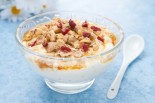Chef and dietitian Abbie Gellman has these simple recipes for you.
YOGURT
Pour milk in a saucepan and bring it to a simmer. Add a little heavy cream if you prefer creamier yogurt. Remove from heat. Add a bit of ready-made yogurt as a starter for the fermentation process. Cover the pot with a towel and let it rest for 6 to 12 hours. Add fresh fruit, granola and/or a natural sweetener and serve.
GRAB-AND-GO GRANOLA BARS
INGREDIENTS:
- 2 cups rolled oats
- 1/4 cup sunflower seeds
- 1/2 cup dried cherries
- 1/4 cup wheat germ
- 1/2 cup chopped walnuts
- 1/4 tsp salt
- 1/2 cup peanut butter
- 3/4 cup honey
- 1 tablespoon flax oil
- 3 tablespoons maple sugar or brown sugar
PREPARATION:
1. Preheat oven to 350 degrees F. Grease a ceramic or glass 9x13 inch baking dish.
2. Mix oats, sunflower seeds, cherries, wheat germ, and walnuts together in a bowl. Spread mixture on a sheet pan and toast in preheated oven for 8 minutes. Return mixture to a large bowl.
3. In a medium saucepan, combine salt, peanut butter, honey, flax oil, and sugar.
4. Bring to a boil over medium heat and immediately remove from heat. Pour over oats mixture and combine until dry ingredients are evenly coated. Stir in chocolate if you are using it.
5. Pour into baking dish. Press mixture down into pan.
6. Bake for 20 minutes.
7. Let cool for up to 2 hours and then cut and serve.
GRANOLA RATIO: The only thing you need to remember is this: 6 parts dry to 1 part wet. Then set oven to 300°F.
MIX THE DRY INGREDIENTS:
- Rolled oats, always. Abbie likes to have at least half of her dry ingredients consisting of rolled oats. Do not use quick-cooking oats.
- Other dry ingredient options include nuts and seeds and/or other rolled, flaked, or puffed grains
- Chopped walnuts, almonds, pumpkin seeds, sesame seeds, puffed millet, coconut flakes
For flavor and texture, aim for a mix of at least four dry ingredients; a good ratio to follow is 3 parts oats, 1 part nuts, 1 part seeds, and 1 part something else.
WHISK THE WET INGREDIENTS:
- Wet ingredients coat the dry ingredients, which helps them brown and clump together
- 1 part wet to your 6 parts dry
- Half sweetener and half oil
- For a neutral flavor, try grapeseed, canola, or sunflower seed oil
- For the sweetener, you need something that's in liquid form, like honey, agave nectar, maple syrup, or brown rice syrup
- Can add an egg white
- Whisk together oil, sweetener, and egg white (if using) until they equal your 1 part measurement, then stir it into your bowl of dry ingredients to coat everything thoroughly.
SEASON TO TASTE:
- cinnamon
- vanilla extract
- cardamom
- nutmeg
- salt
BAKE UNTIL GOLDEN-BROWN:
Line a rimmed baking sheet with parchment paper, then spread your granola mixture out in an even layer.
Bake at 300°F, gently stirring every 15 minutes, until the granola is golden-brown and dry, 40 to 45 minutes.
If you want dried fruit in your granola such as dried cherries, cranberries, raisins, or sliced dried apricots, add it at the end.
Let the whole thing cool completely then store in pantry.

 Abbie Gellman, MS, RD, is a professionally-trained chef and Registered Dietitian. Abbie has over 10 years of hospitality and food and beverage consulting experience and nearly 10 years of nutrition-related experience.
Abbie Gellman, MS, RD, is a professionally-trained chef and Registered Dietitian. Abbie has over 10 years of hospitality and food and beverage consulting experience and nearly 10 years of nutrition-related experience.